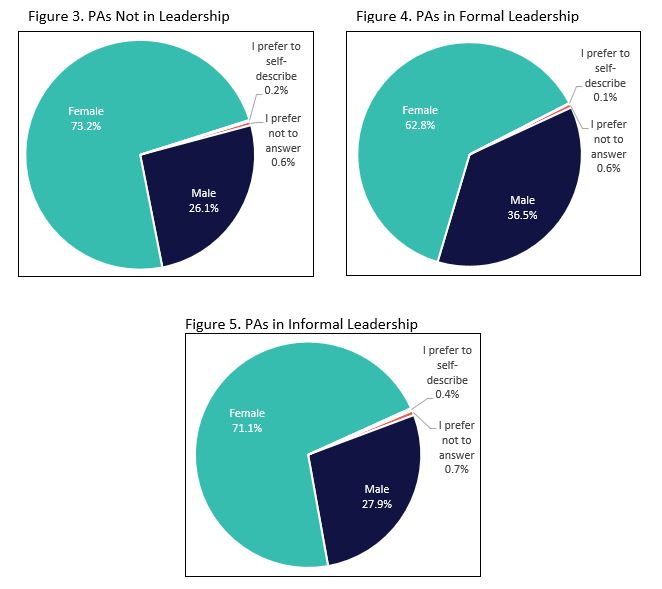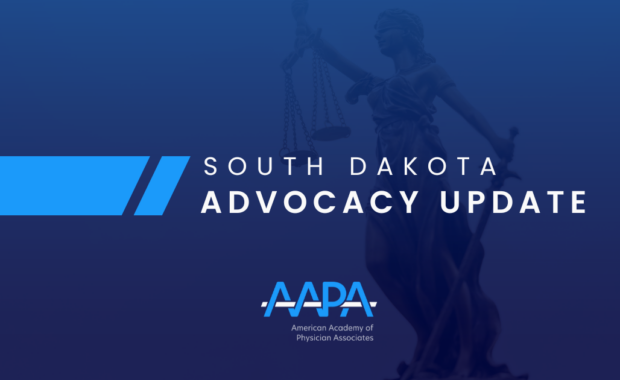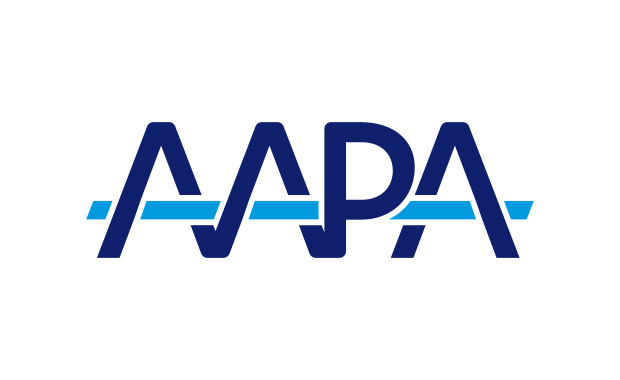Five Things You Might Not Know About PAs in Leadership
Survey: Both Formal and Informal Leadership Opportunities are Rewarding for PAs
By AAPA Research
Almost 30% of PAs who responded to the 2022 AAPA Salary Survey served in an informal (18.1%) or formal (12.3%) leadership role within their workplace. While many pursue these leadership tasks as they clinically practice, some formal leadership positions provide management and administrative opportunities. To learn more about these PAs, we gathered information on key areas of difference and reported our findings in the 2022 AAPA Salary Report. Here are five highlights from our analyses:
[Get the full scoop on PA salaries as an AAPA member – join or renew today]
- Compensation varies by leadership activity
 Leadership activities had an impact on PA compensation. Among PAs who worked at least 32 hours a week, those who served in formal leadership roles had a median income of $130,000 while PAs who reported not having any leadership tasks had a median compensation of $112,632. These results are illustrated in Figure 1. However, it is important to note that PAs in leadership roles typically have more work experience. Informal leaders (8 years) and formal leaders (13 years) have higher median years of experience than those with no leadership tasks (5 years).
Leadership activities had an impact on PA compensation. Among PAs who worked at least 32 hours a week, those who served in formal leadership roles had a median income of $130,000 while PAs who reported not having any leadership tasks had a median compensation of $112,632. These results are illustrated in Figure 1. However, it is important to note that PAs in leadership roles typically have more work experience. Informal leaders (8 years) and formal leaders (13 years) have higher median years of experience than those with no leadership tasks (5 years).
- PAs serving as Vice/Senior Vice Presidents have the highest compensation in leadership
Figure 1 illustrates how PAs in formal leadership positions had the highest median compensation among PAs in leadership, but there was also variance between the categories of formal leaders. Lead PA/APP made up the largest subset of formal leaders, earning a median compensation of $130,000. Most of these PAs (64.1%) received a bonus, with a median bonus amount of $6,000. Vice President or Senior Vice President PAs made up the smallest subset of those in formal leadership positions, but this group had the highest median compensation ($180,000), were most likely to receive a bonus (75%), and had the highest median bonus amount ($20,000) among PAs in formal leadership positions.
- Informal leaders serve in a variety of roles
In the 2022 AAPA Salary Survey, we asked PAs who identified as informal leaders to define what “informal leadership” meant to them. The responses to this question are displayed within the word cloud in Figure 2. Among the responses, three prominent themes emerged. First, informal leadership was often related to education, onboarding, or training of new PAs. Second, informal leadership could include positions on committees, such as membership on a hospital wellness or DEI committee. Finally, positions with “unofficial” supervisory duties in a medical team, such as in a short-staffed department, were also classified as informal leadership tasks.

- Gender distribution varies across leadership categories
The gender distribution of PAs not in leadership positions and those performing informal leadership roles was similar to the overall gender distribution of PAs across the profession. However, the distribution of male PAs in formal leadership roles was slightly higher. Male PAs made up 36.5% of the formal leadership category, and almost two out of every ten male respondents in the 2022 AAPA Salary Survey (16.3%) were in a formal leadership role. Comparatively, only 10.9% of female PAs in the 2022 AAPA Salary Survey had formal leadership positions. These gender differences within each of the leadership categories are presented in Figures 3, 4, and 5.

- Informal leaders are more likely to experience burnout
The 2022 Salary Survey asked respondents to select a response based on how burned out they felt in their position during 2021. Generally, the proportion of respondents experiencing elements of burnout across the leadership categories were similar to the national total. However, PAs performing informal leadership tasks reported slightly more feelings of burnout than the other leadership categories. These differences in burnout between leadership types were statistically significant†. PAs in informal leadership experienced more burnout than those in formal leadership, and informal leaders were more burned out than PAs who were not in leadership.

*Median total compensation includes PAs who worked more than 32 hours and were paid a base salary, an hourly wage, or had productivity pay. Hourly wage data was annualized. Total compensation includes bonuses awarded in 2021.
† Overall ANOVA significance was F = 11.4, p < .001. The difference in burnout between informal and formal leaders was significant (p <.05, 95% CI = .01, .18 ), and the difference in burnout between informal leaders and PAs not in leadership was also significant (p < .001, 95% CI = .06, .19).
This article was written by Sean Kolhoff, Ph.D., Senior Research Analyst at AAPA. Contact him at [email protected].
You May Also Like:
2022 AAPA Salary Report
Expert Insights on Barriers to Clinician Well-Being
Top 10 Paying Specialties in 2021
Leadership on Demand
Thank you for reading AAPA’s News Central
You have 2 articles left this month. Create a free account to read more stories, or become a member for more access to exclusive benefits! Already have an account? Log in.



